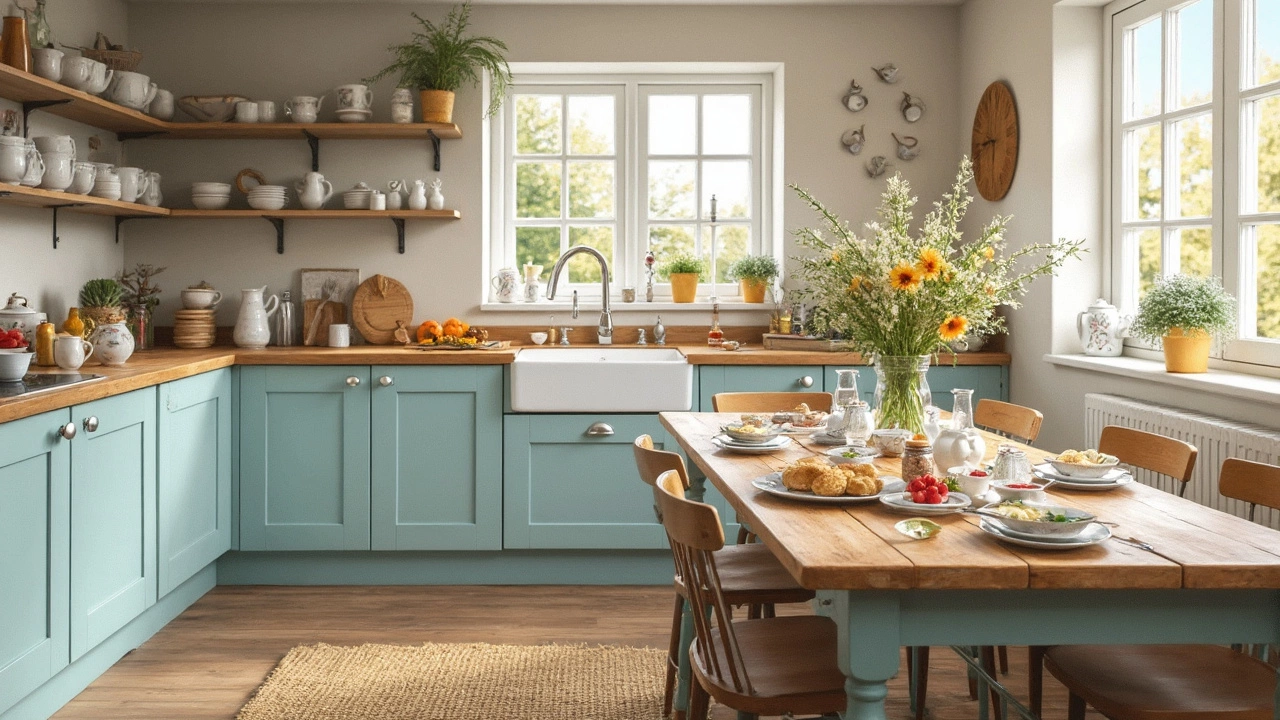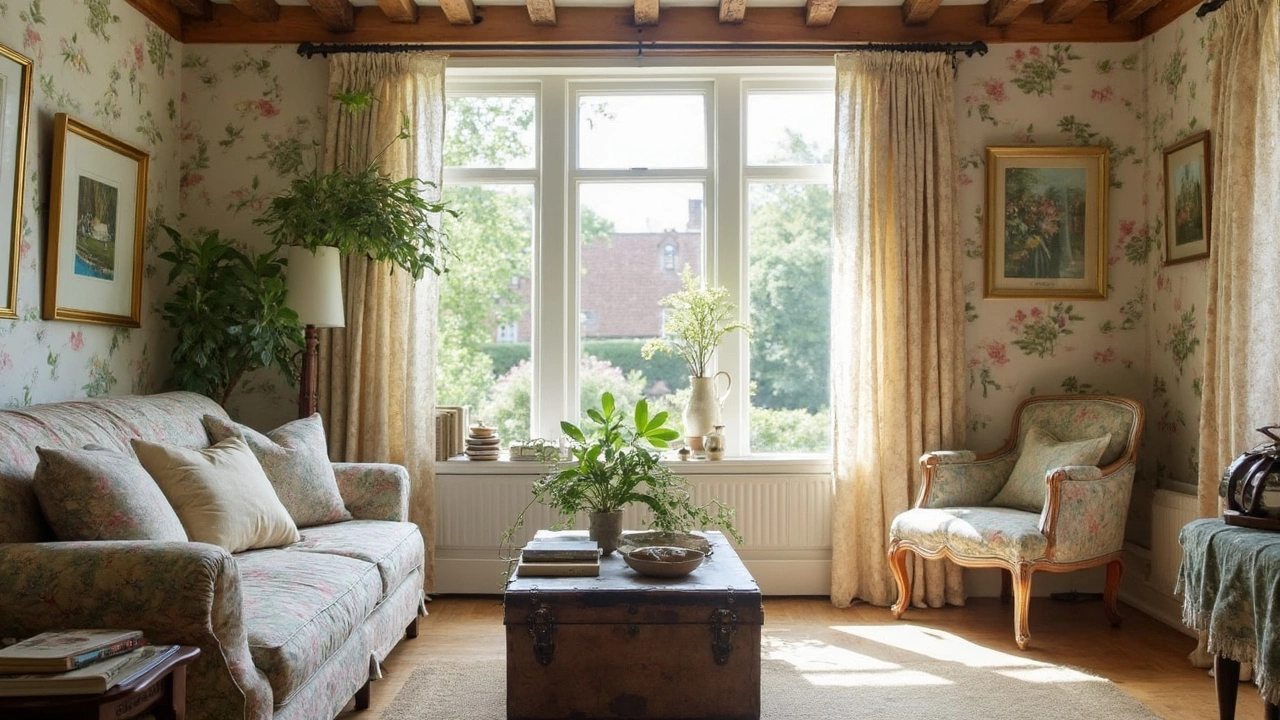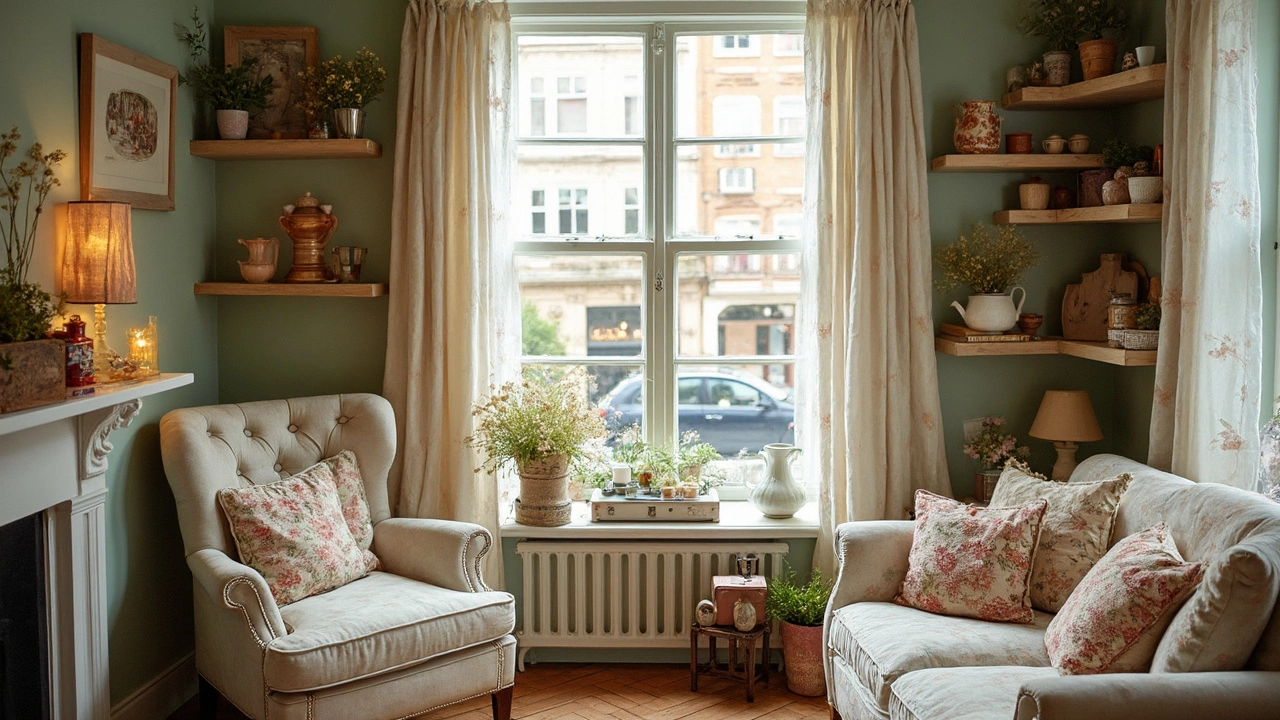Have you ever caught yourself pinning pictures of those dreamy old cottages and wish your own home had that storybook glow? Folks pay big money to rent rural Airbnbs, desperately searching for that snug, lived-in charm. But turning your house into a country cottage isn’t about buying everything in a single shopping haul or living next to a sheep pasture. It’s about the feel—the warmth that welcomes you, the personal touches that make even chilly mornings pleasant, and the details that remind you of happy, simple days. You might be surrounded by city life, but the cottage look? It’s all about what you create inside.
Choosing Soft Colors and Layered Textures
Step into any real country cottage, and the first thing you’ll notice is never bold patterns or trendy neon. Cottage style thrives on peace, best delivered with soft, light colors. Think creamy whites, pale sage greens, faded sky blues, or gentle greys. If you want authenticity, try painting your walls with a matte finish rather than anything glossy. That’s exactly what you’d find in timeworn farmhouses, where sunshine and age have dulled the shine off every surface over decades. Benjamin Moore’s ‘White Dove’ and Farrow & Ball’s ‘Skimming Stone’ are two colors that have actually topped country home design lists for years.
Floors make a massive difference. Wide-plank wood floors with visible knots instantly channel that rustic vibe, whether you go for real reclaimed boards or just a layered laminate that’s kinder on the wallet. Top them off with a jumble of Persian-style rugs or handwoven mats with faded, sun-bleached colors. Avoid those bright, geometric synthetic rugs—they stand out like a sore thumb here. Instead, every room should have a texture that asks to be touched: chunky knits, linen drapes that catch the breeze, and velvety cushions begging for a nap.
If you’re worried about too much white, add color thoughtfully with throws, floral cushions, or soft, pastel ceramics on your shelves. Embracing prints is easy: choose classic gingham, tiny ditsy florals, or faded stripes. The secret is restraint—too much pattern can erase the very calm you’re trying to create. Layering is key, too. Stack a cozy blanket on the couch, drape a crocheted runner across the table, hang mismatched towels in the kitchen. Try a sweet little trick: buy inexpensive vintage scarves from charity shops and use them as covers for old throw pillows. It’s budget-friendly, unique, and the results always feel joyful.
Don't forget your windows. Flimsy voile curtains, delicate lace, or lightweight linen let in the most light and add instant romance. Ditch any heavy, blackout drapes. If your window frames are plain, paint them a slightly contrasting color for a quick historic touch. I painted mine a soft duck-egg blue, and even Whiskers prefers watching the world from there now.
Lighting matters, too. Swap harsh white bulbs for warm Edison-style ones, or add table lamps in ceramic bases—bonus points if they look a little chipped or timeworn. Wicker basket shades, antique sconces, and candles in jars pull everything together. According to a 2024 survey by Houzz, 62% of people aiming for a cozy home said switching up lighting was the biggest mood booster.
There’s even research to back up the science of softness. A study from Cornell University found that rooms decorated in muted, natural colors were rated as 40% more relaxing by test subjects than brighter, more modern palettes. More than half even said it improved their overall mood, simply by entering the room. That’s something you’ll notice every day, whether you’re reading on the sofa or sneaking in a catnap beside the fire.

Mixing Vintage Finds with Natural Materials
If a country cottage could talk, it’d probably tell you stories about hand-me-downs, not about designer sets. The spirit of cottage style lies in the objects that feel like they have a history—whether they actually do or not. So, the next time you wander through a flea market, think less about matching and more about character. An enamel jug with a chip, a battered basket, a mirror with a bit of fog on the edge—these are golden finds. Don’t overlook battered wooden chairs, chunky candlesticks, or tins with faded labels. They make everyday moments feel timeless.
You don’t need an eye-watering budget to get started. Charity shops brim with old plates (the more mismatched, the better), brass candlesticks, or those classic English teapots. If you’re tight on time, browse local online sales or community ‘freecycle’ groups—sometimes, people are literally giving away classic cottage treasures. A table of actual thrifted prices might surprise you:
| Item | Shop Type | Average Price (USD) |
|---|---|---|
| Vintage Jug | Flea Market | $7 |
| Lace Tablecloth | Charity Shop | $6 |
| Painted Tin Box | Online Buy/Sell | $3 |
| Wicker Basket | Estate Sale | $10 |
| Set of Plates (4) | Consignment | $14 |
Now, blend those vintage treasures with lots of natural elements. Wood tops the list—coffee tables with rough edges, chunky farmhouse benches, shelves that look hand-built, or even a simple ladder used to hang towels. Don’t sand everything smooth; knots and nicks just add to the storybook look.
Mix in stone, clay, and woven baskets. Terracotta pots—even the slightly cracked ones—look lovely in groups. Fresh or dried lavender in a jug invites a little countryside inside. Weave in baskets for everything: logs, magazines, even Whiskers’ toys. The more casual, the better—it’s not meant to be museum-perfect. Old books become instant decor piled on a side table, especially if you wrap them in brown paper or twine. Try adding an old wooden crate to hold firewood or as a quirky shoe rack in the hall—pure, practical cottage genius.
Plants can’t be skipped, and you don’t need a green thumb. Ivy, pothos, or ferns love indirect light and fill awkward corners instantly. You’ll find English homes are famous for sprawling window sills with little pots of herbs. Daily country life always involved growing something—even if it’s just a stately basil plant beside the sink to snip for dinner. Even “cottagecore” obsessed TikTokers have revived the classic idea of the kitchen garden, and videos with fresh-cut wildflowers in old glass jars rack up millions of views.
When bringing in the rustic look, skip anything overly mass-produced or “fake vintage.” Real age isn’t required—but go for pieces that at least look like Grandma could’ve owned them. If you’re handy, sand and repaint old furniture in chalky whites, muted greens, or soft blue. Swap plain cupboard handles for porcelain knobs. And, if you’re feeling creative, try stenciling small flowers or ivy trails onto a dresser to bring some joyful color back into tired wood.

Creating a Welcoming, Lived-In Atmosphere
What you’re after isn’t just a look—it’s a feeling that wraps around you the second you step in the door. The real magic of a cottage is the sense of welcome, the idea that it’s been lived in by real people and pets (yes, even fur balls like Whiskers). Every object is either useful, meaningful, or a secret smile—you know, that quirky teacup or the cross-stitched cushion gifted by an aunt.
Start with your entryway. Shoe racks made of rough-hewn wood, a row of hooks for raincoats and old hats, a gingham or floral runner—this sets the tone before anyone’s even inside. A small bench or a woven baskets for storing bags makes it practical, too. Real cottage homes have a grab-and-go spirit, not “don’t touch the decor” vibes.
Kitchens are the true heart of every country home. Hang racks for displaying chipped crockery or enamel pans, even if you can only manage a shelf above your sink. Invest in open shelving to show off those mismatched mugs and set out a pot of fresh herbs—a sprig of rosemary or mint is all you need. Fill glass jars with flour, sugar, or rice and line them up on display. If you bake, hang a set of well-loved rolling pins or a basket of eggs on the counter. A 2022 survey in Country Living magazine found that a whopping 86% of readers polled said open shelving was their favorite kitchen detail for evoking cottage charm.
Now onto the living rooms and bedrooms—pile up layers. Stack books beside your bed, add knitted throws across sofas, and display photos in mismatched frames. Don’t worry if things don’t match. The best country rooms feel like they’ve grown and changed with their owners, not dropped in from a catalog. For scent, my favorite trick is to simmer a saucepan with apple slices, cinnamon sticks, and a little vanilla. Guests will step through your door and immediately feel…something nice, even if they can’t put their finger on it.
Even bathrooms can join the cottage fun. Swap modern soap dispensers for glass jars or enamel dishes. Rolled hand towels in a little wooden box, a jug of dried lavender, or even a scrub-brush in a pretty holder make daily routines feel just a bit more special. And if you’re ready for a small renovation, beadboard panelling in soft grey or white transforms any bathroom into a charming retreat. A survey by The Spruce in 2023 found that 67% of homeowners who introduced wood panelling rated their mood in the bathroom much more positively—even first thing in the morning.
If you have pets (I’ve got cat hair everywhere, courtesy of Whiskers), cottage life works in your favor. Baskets double as toy bins, washable throws are a must, and floorboards actually make cleaning a breeze. A friend of mine even turned a battered suitcase into a cat bed with a pile of soft blankets; she gets more compliments on it than anything else in her house.
Little details add so much warmth: a watering can in the hallway, a clip-on reading lamp over a comfy armchair, a collection of postcards pinned to the pantry door. Fresh flowers—or, on lazy weeks, dried grasses in a jug—keep your home feeling lived-in, not staged. And if you’re crafty, try your hand at making bunting from scraps of fabric, or sewing a few simple cushion covers by hand. No one expects perfection; handmade touches make your space feel truly yours.
The most persuasive thing about a country cottage is that it doesn’t pretend—nothing feels forced. The best rooms seem to have been shaped by daily life, laughter, baking mishaps, and maybe the odd dog-chewed slipper. Cottage style isn’t a trend; it’s a way of making every visitor (yourself included) linger just a little longer, content to be among life’s gentle chaos. So next time you’re thinking your home’s missing that magic, just remember: a welcoming cottage feel is all about adding comfort, a few quirks, and just enough disorder to feel like you’re right at home in the countryside—even if your nearest green field is a city park.
